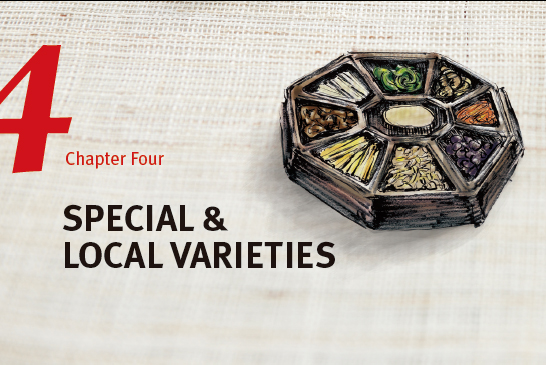
Korean cuisine has developed its own flavors and character according to region and class. In the highly stratified society of the Joseon Dynasty (1392-1910), each social class developed its own culinary culture. The royal court had its cuisine, the elite yangban class had its own cuisine, and the commoners had their cuisine. Religion also played a factor, with Buddhists developing a unique Buddhist temple cuisine.
The result has been an incredibly varied cuisine, despite Korea’s relatively small size. In modern times, these various cuisines have transcended their original class, religious and regional boundaries, and can now be enjoyed by most everyone everywhere, although regional dishes are still best enjoyed in their regions of origin. Buddhist cuisine, too, is probably best enjoyed in the peaceful serenity of Korea’s Buddhist monasteries, though restaurants specializing in Buddhist cooking can be found even in the heart of Seoul.
SPECIAL CUISINES
Banga Cuisine
Banga cuisine is the food of the yangban, the scholar elites that dominated Korean society in the Joseon era. It is characterized by “family foods” passed down through the generations, with plenty of regional variation. When yangban took government posts, they would come up to Seoul, but they would never forget their hometown food, so each yangban house had its own special dishes. The yangban also took cues from palace cuisine, developing in their food a unique taste and style that would become known as hyangto (local) food.
As yangban cuisine differed from house to house and region to region, it was usually passed down by the wives in the family. This became the model of Korean cuisine, with many traditional dishes preserved thanks to Confucian ideology.
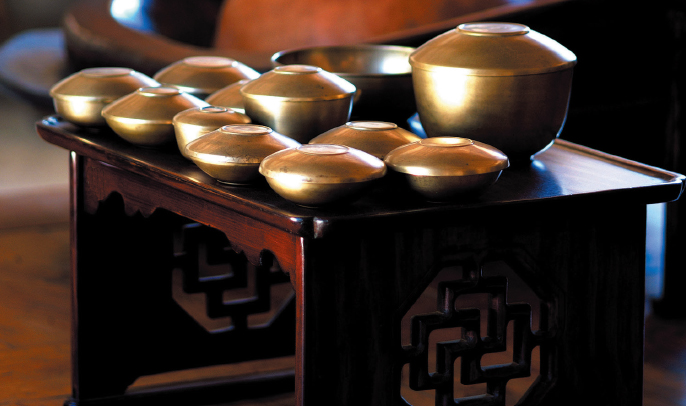
Traditional bangasang. Each dish is covered to keep it warm.
Palace Cuisine
Korean royal palace cuisine, as the name would suggest, was the style of Korean cooking traditionally reserved for the court of the Joseon Dynasty. With the fall of the dynasty and the end of the monarchy, palace cuisine almost became a lost art, but it was preserved by a few chefs who kept the cuisine going, mostly at private restaurants for high-end clients. In the 21st century, it has witnessed a revival, its popularity boosted by popular media and the so-called Korean Wave, which has brought the beauty of Korean palace cuisine to media markets in China, Japan, and elsewhere in Asia.
Korean palace cuisine reflected the grandeur and flair of Korea’s kings of old. Palace cuisine served as a national showcase: the king’s dinner table featured dishes from all over the Korean Peninsula, as well as surrounding nations. Each region in Korea sent its local specialties to the palace for the king to consume. Unlike commoners, whose food was seasonal, the king’s dinner table changed day to day. Accordingly, each month the governors of Joseon’s eight provinces presented the court with their local ingredients, giving palace chefs an incredible wealth of ingredients with which to work.
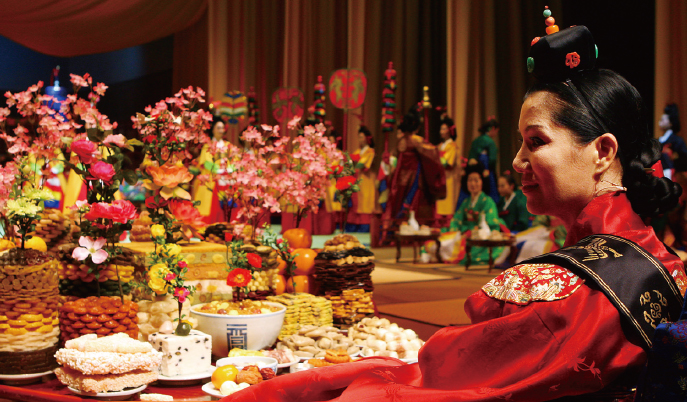
Reenactment of Joseon queen's 60th birthday.
Food was taken very seriously by the Joseon government. Government ministries included positions dedicated to the procurement of food and drink for the royal family. For example, the Ministry of Personnel contained positions responsible for obtaining rice for royal consumption. The Ministry of Rites prepared sacrificial foods for ancestral rites, and procured alcoholic beverages and medicinal foods. Within the palace, there were countless servants and court maids who prepared dishes such as tofu, alcoholic beverages, tea, and rice cakes. The court maids in particular served as the palace cooks, serving with government bureaus such as the Bureau of Special Food and Bureau of Cooking Food. During major banquets, the female cooks might be assisted by male cooks from outside the palace.
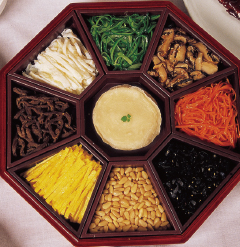
Gujeolpan is a dish consisting of nine different foods served on a wooden plate with nine sections.
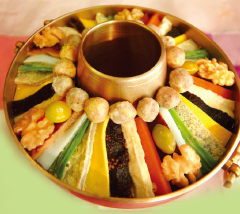
Sinseollo, a variety of jeongol, is boiled in meat stock with various vegetables and mushrooms in a particular type of cooking pot with holes.
During the Joseon Dynasty, five meals a day were served in the royal palace. Of these, two were full-course meals, while three—the pre-breakfast, afternoon, and after-dinner meals—were lighter. These meals were:
•Mieumsang (Pre-breakfast): The first meal of the day, this was served to the king and queen at sunrise and usually consisted of rice porridge (juk) made from abalone, white rice, mushrooms, pine nuts, and sesame. The porridge was often accompanied by side dishes like kimchi, oysters, and soy sauce. This meal was thought to boost the royal couple’s vitality.
•Surasang (Full-course): Breakfast and dinner were the two main meals of the day and consisted of two types of rice, two types of soup, two types of stew, a dish of steamed meat, a casserole, three types of kimchi, three sauces, and 12 side dishes. These were served in a special dining room, with the king seated to the east and the queen to the west, attended by court maids. Typically, the meal was served with three tables and a hot pot. The largest table would be placed at the bottom left (from the king’s perspective); this contained the rice, soups and stews, and side dishes. A smaller table would be placed at the bottom right; this would contain thicker meat soups and desserts, as well as provide a place to put empty bowls. Sauces, raw vegetables, eggs, and sesame oil would be placed on a table at the upper right. Finally, a heated hot pot table would hold the casserole.
•Natgeonsang (Afternoon): Lunch was usually a simple affair of porridge, but when guests came they were usually treated to noodles and dumplings.
•Yachamsang (After-dinner): A simple evening snack was sometimes served to the king and queen as well.
DAE JANG GEUM
The popular Korean drama Dae Jang Geum starring actress Lee Young-ae, told the tale of a palace cook in the Joseon era. A hit in China and other Asian markets, the show provided a look at Korean palace cuisine and the culture that surrounded it.
Loosely based on the historical figure during the reign of King Jungjong (r. 1506-1544) as depicted in the Annals of the Joseon Dynasty, the show focuses on Jang-geum (played by Lee), the first female royal physician of the Joseon Dynasty. The main themes are her perseverance and the portrayal of traditional Korean culture, including royal court cuisine and traditional medicine.
Dae Jang Geum enjoyed extensive success throughout Asia, in places such as China, Taiwan, Hong Kong, Malaysia, Singapore, Brunei, Japan, Indonesia, the Philippines, Thailand, and Vietnam, further continuing the “Korean Wave” cultural fever that has gripped Asia since the early 2000s. It has also been shown in Australia, the United States, Sweden, Russia, Iran, Saudi Arabia, Turkey, Peru, Egypt, Romania, Canada, India, Israel, Hungary, and New Zealand. (Adapted from Wikipedia)
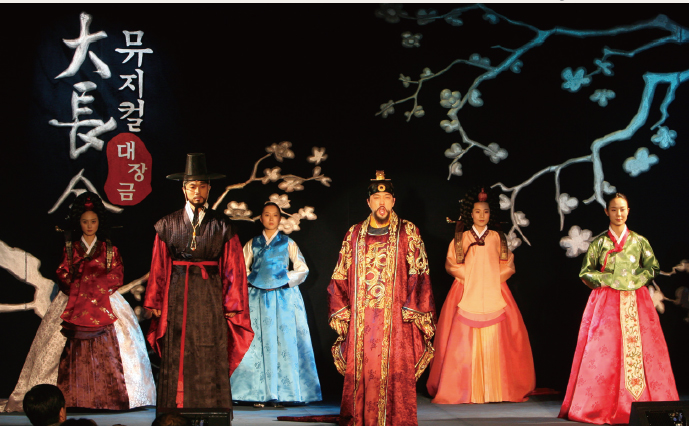
Musical version of the hit Korean Wave drama Dae Jang Geum,
Temple Cuisine
Korean temple cuisine is a reflection of the basic spirit of Buddhism. Dishes are kept simple, while ingredients are kept as pure as possible, allowing their intrinsic tastes to shine.
In accordance with Buddhist principles, temple cuisine does not use meat, nor does it use the osinchae, or “five stimulating seasonings” (garlic, green onions, wild chives, regular chives, and heunggeo), giving temple cuisine a simple, pure taste.
For ingredients, temple food uses mountain vegetables, field vegetables, roots, berries, bark, and seaweed. The cooking process is simple and designed to preserve as much as possible the original taste of the major ingredients. Accordingly, artificial seasoning is kept to a bare minimum. It’s an odd contradiction that Buddhism, which seeks to minimize our appetites, has at the same time elevated the taste of its food to untold heights.
Until recently, this cuisine was the preserve of temples sheltered from the mundane world. Now, however, opportunities to experience this cuisine are expanding, especially as vegetarianism continues to grow in popularity as a healthy alternative.
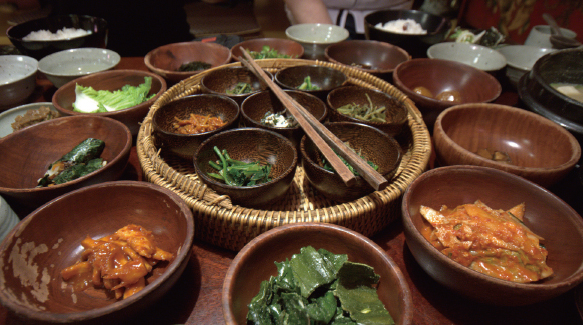
Menu at a Korean temple cuisine restaurant in Insa-dong. The table is covered with vegetables, salads, fried goods, and doenjang stew.
LOCAL CUISINES: SOUTH KOREA
The Korean Peninsula stretches in a north-south direction from the Northeast Asian mainland and is surrounded by water on three sides. Accordingly, the topographic and climactic conditions found throughout the peninsula are quite diverse, producing a wide variety of hyangto (local) foods. Each province produces a great many dishes unique to its locality. In the 20th century, however, the development of national transportation, ease of delivery, and a widening distribution net have had an impact on local cuisine.
Seoul
Seoul itself doesn’t produce much agriculturally, but it takes ingredients from throughout the country to produce a wide variety of succulent dishes. Among Korean cities, Seoul, Gaeseong, and Jeonju have the most diverse and eye-catching local cuisines.
As it was the capital of the Joseon Dynasty for 500 years, Seoul still maintains many of the culinary traditions of the period, including its preference for mild dishes that are neither spicy nor salty. Home to many royals and yangban, Seoul was quite strict about its culinary rules and placed a lot of emphasis on presentation. Dishes: Sinseollo (royal casserole), gujeolpan (nine-sectioned plate), seolleongtang (beef soup), yukgaejang (spicy beef soup), galbi jjim (braised meat short ribs)
Gyeonggi-do
With rich fishing grounds to the west and plenty of wild mountain vegetables in the east, Gyeonggi-do produces a wide variety of foodstuffs, including rice and dry-field agricultural goods. Dishes tend to be simple and many, and presentation is pleasantly plain, with the exception of Gaeseong, which was incorporated into North Korea after the Korean War. In Gaeseong, the old royal capital of Goryeo, the cooking style is quite sumptuous (see more). Dishes: Galbi (grilled short ribs), samgyetang (chicken-ginseng soup), kongguksu (cold soybean noodle soup), ogokbap (steamed five cereal crops), Gaeseong: joraengi tteokguk (Gaesong style rice cake soup), bossam kimchi (wrapped kimchi), gyeongdan (ball-shaped rice cake), chueotang (mudfish soup)
Gangwon-do
With its many mountains and high plains, Gangwon-do produces a lot of corn, buckwheat, and potatoes; accordingly, it produces many dishes using these ingredients. The East Sea, meanwhile, produces pollack, squid, and seaweed, a fact well represented in local cuisine. Dishes: Makguksu (buckwheat noodle), gamjajeon (potato pancake), ojingeo sundae (blood sausage stuffed with squid), myeongnan jeot (seasoned pollack roe)
Chungcheong-do
One of Korea’s primary agricultural regions, Chungcheong-do produces large amounts of rice, barley, sweet potatoes, radishes, cabbage, cotton, and ramie. Its west coast, meanwhile, produces much seafood. Since the days of the Baekje Kingdom, the region has produced a good deal of rice. Its local dishes are quite simple in presentation, representing the simple manners of the local residents.
Chungcheong-do residents have traditionally enjoyed doenjang; in winter, they like heartier soups like cheonggukjang. Locals tend to go easy on spices, instead preferring to let the natural taste of the food come through. The local cuisine is simple and plain-tasting, in sharp contrast to the cuisines of Gyeongsang-do and Jeolla-do. Dishes: Kalguksu (knife-cut noodle soup), jeyuk bokkeum (stir-fried pork in gochujang) kongnamul bap (rice cooked with sprouts), cheonggukjang jjigae (fermented soybean stew)
Jeolla-do
Possessing perhaps the most famous of Korea’s local cuisines, Jeolla-do produces a wide variety of grains, seafood, and wild vegetables compared to other regions, and the food it produces is especially extravagant. In localities like Jeonju, Gwangju, and Haenam, wealthy noble families have lived together, handing down within households good foods with incomparable style and taste. While Gaeseong in Gyeonggi-do has been quite conservative in its culinary culture, protecting the cuisine of the Goryeo Dynasty, Jeolla-do has kept the culinary traditions of Joseon. It uses ingredients well, producing a wide range of dishes. The bean sprouts of Jeonju are particularly noted for their flavor.
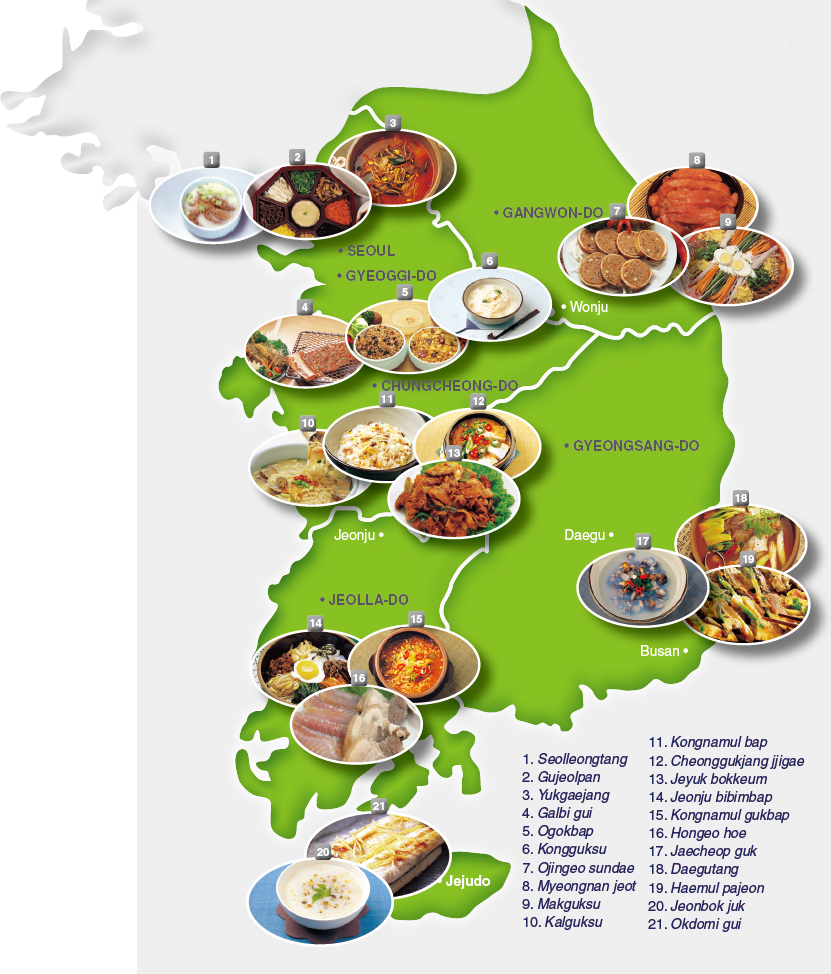
Jeolla-do cuisine is famous for filling the table with a lot of side dishes; this can surprise first-time visitors to the region. Bordering both the South and West Seas, the region produces many kinds of unique seafood products and jeotgal. Due to the warm weather, the flavors tend to be spicy and provocative, with liberal use of gochujang (chili paste). Dishes: Jeonju bibimbap (mixed rice of Jeonju), kongnamul gukbap (soybean sprout soup with rice), hongeo hoe (fermented skate), kkaejuk (sesame porridge)
Gyeongsang-do
Gyeongsang-do has good fisheries to the south and east, so it is rich in seafood and it has rich farmland on the banks of the Nakdonggang River. Its dishes tend to be salty and spicy, but not as extravagant as Jeolla-do cuisine. Residents also like to salt fresh fish and boil fish stews. Dishes: Daegutang (cod stew), miyeok honghap guk (seaweed soup with mussel), haepari hoe (raw jelly fish), haemul pajeon (seafood pancake), jogae jjim (steamed seashells), jaecheop guk (a clear soup made with small freshwater clams)
Jeju-do
Jeju-do produces hardly any rice, but it produces a lot of beans, barley, millet, and sweet potatoes. It is especially famous for its mandarin oranges and abalone.
Jeju-do dishes use a lot of fish and seaweed (not surprising, given that it’s an island), and locals use doenjang to season dishes. They also enjoy fish stews and porridge.
Jeju-do residents reflect their native industry and simplicity in their dishes: they rarely mix many ingredients together, and they don’t use much seasoning. Dishes tend to be on the salty side. Also unsurprisingly, they eat a lot of raw fish. Dishes: Jeonbok juk (abalone porridge), okdom juk (tilefish porridge), okdom gui (grilled tilefish)
LOCAL CUISINES: NORTH KOREA
Pyeongan-do
Pyeongan-do cuisine is characterized as a continental style due to a lot of interaction with China dating back to ancient times. Dishes are made into large shapes, so the table looks rich and abundant. Jobap, a bowl of mixed steamed rice and millet, is commonly served in place of ssalbap (steamed rice without any other grains), and foods made with grain flour such as noodle dishes—especially naengmyeon (cold buckwheat noodles)—and mandu (dumplings) are common Pyeongan dishes. The cuisine’s taste is generally bland, with fatty foods being enjoyed during winter. Dishes: Dwaejigogi jeon (pork pancakes), dongchimi (water kimchi), baek kimchi (kimchi seasoned without chili pepper powder), mujigae tteok (rainbow rice cake)
Pyongyang
Pyongyang, the capital of North Korea, was the capital of Gojoseon, and the provincial capital of Pyeongan-do until 1946. Therefore, Pyongyang cuisine shares the general culinary tradition of Pyeongan-do. The most famous local food is Pyongyang naengmyeon, also called mul naengmyeon. Naengmyeon literally means “cold noodles,” while the affix mul refers to “water,” as the dish is served in a cold soup. Dishes: Pyongyang naengmyeon (cold buckwheat noodle soup), eobok jaengban (pressed beef served in a brass plate), Pyongyang manduguk

Hamgyeong-do
Hamgyeong-do lies in the far northern region of the Korean Peninsula, comprising steep mountains and valleys while facing the East Sea. Cereal crop farming is developed in the region, so a diverse range of high-quality cereals is harvested, including millet, barnyard millet, sorghum, soybeans, and corn. The quality of potatoes and corn is also high, so the starch obtained from these crops is used to make noodles. Although Hamgyeong-do cuisine is not salty, garlic and chili pepper are heavily used as seasonings. Hamhung naengmyeon, which originates in the city of Hamhung, is a cold noodle dish topped with hoe (sliced raw fish) seasoned with a hot and spicy sauce. Dishes: japgokbap (a bowl of cooked mixed multiple grains), jjin jobap (steamed sorghum), dak bibimbap (mixed rice and vegetables with chicken slices), eollin kongjuk (porridge made with frozen soybeans), oksusu juk (corn porridge), Hamhung naengmyeon, gamja guksu (potato noodles)
Hwanghae-do
Hwanghae-do is a granary of North Korea and is known for its production of good-quality cereal. The abundant production of cereal crops leads to a higher quality of feed for livestock, so the quality of meat produced in the region is said to be good. Chickens are raised in every household, and the meat is fleshy and of good quality, so it is used for many dishes in Hwanghae-do cuisine. Chicken is used as an ingredient in wheat noodle dishes and mandu (dumplings). Due to the climate, the kimchi of the Hwanghae region has a clear and refreshing taste, so its brine is used as a soup on many occasions. Hwanghae-do dishes are savory and simple, with less decoration. The most famous Hwanghae-do dish is Haeju bibimbap, originating in the city of Haeju. Dishes: Haeju bibimbap, japgokbap (rice with multiple grains), sundubu jjigae (spicy soft tofu stew, bindaetteok (mung bean pancake), cheongpomuk (seasoned mung bean starch jelly)